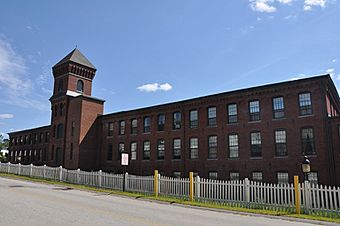Pembroke Mill facts for kids
Quick facts for kids |
|
|
Pembroke Mill
|
|
 |
|
| Location | 100 Main St., Pembroke, New Hampshire |
|---|---|
| Area | 2.2 acres (0.89 ha) |
| Built | 1860 |
| Architectural style | Renaissance Revival |
| NRHP reference No. | 85002188 |
| Added to NRHP | September 12, 1985 |
The Pembroke Mill, now called the Emerson Mills Condominiums, is a very old and important building. It is located at 100 Main Street in the village of Suncook. This village is part of the town of Pembroke, New Hampshire. The mill stands right on the north bank of the Suncook River.
Built in 1860, this mill is a great example of Renaissance Revival style architecture. It played a huge role in making Suncook an important economic center. Today, the mill building has been turned into homes. It was added to the National Register of Historic Places in 1985.
The Historic Pembroke Mill
What Does It Look Like?
The Pembroke Mill is found near the center of Suncook village. It is a large, rectangular building made of brick. It stands four stories tall.
The most striking part of the building is its tower. This tower is five stories high, like a tall bell tower. It has narrow arched windows and wider arched doors on its lower levels. Above these, you can see fancy brickwork and a slate roof that flares out. The very top level has single arched windows on each side. Above these are more arched designs that hold up the pointed slate roof. The building also has many windows with arched tops.
A Look Back in Time
The land where the Pembroke Mill stands has a long history of industry. As far back as the 1700s, there were sawmills and gristmills here. These mills used the power of the Suncook River's waterfalls.
In 1860, a new company called the Suncook Manufacturing Company was formed. They bought up land and water rights on both sides of the river. The Pembroke Mill was the very first building they completed that same year. The company also built other mills nearby. They built the Webster Mill upstream, which is no longer standing. They also built the China Mill downstream, on the other side of the river, which you can still see today.
After the Pembroke Mill was built, the number of people living in Suncook tripled in just ten years! The way the village's downtown looks even today shows how important the mill was to its growth.



